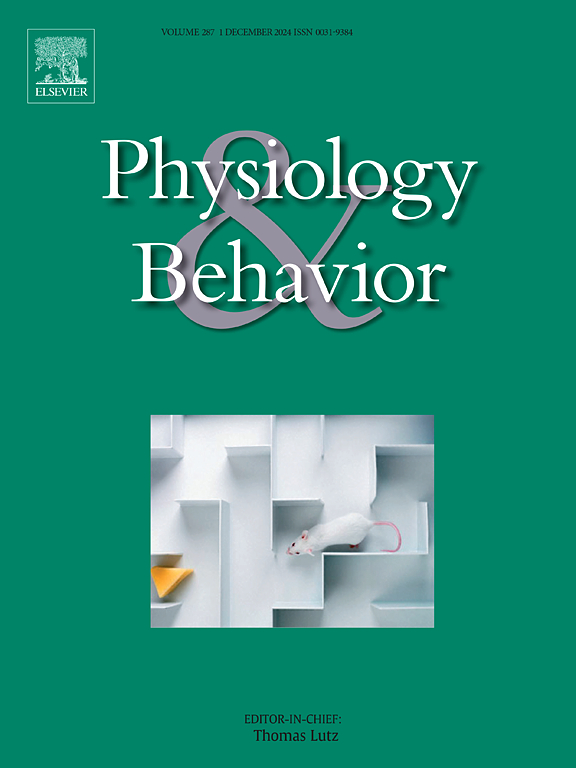Mechanisms underlying sustained resilience against anorexia nervosa from sub-anesthetic ketamine: A review and new research based on electron microscopic analyses of synapses using a mouse model
IF 2.5
3区 医学
Q2 BEHAVIORAL SCIENCES
引用次数: 0
Abstract
The activity-based anorexia (ABA) animal model captures key maladaptive behaviors of anorexia nervosa – starvation-evoked hyperactivity, voluntary food restriction, severe weight loss and elevated anxiety-like behavior. By repeating ABA induction, the model reveals an animal’s gain of resilience against ABA relapses and concomitant synaptic plasticity. We review findings on the efficacy of sub-anesthetic ketamine administered during ABA in mid-adolescence in gaining resilience against ABA relapses, and the molecular changes evoked at medial prefrontal cortex (mPFC) synapses. GluN2B-containing NMDA receptors are significantly greater at excitatory synapses on dendritic spines of pyramidal cells. Drebrin, an F-actin binding protein that promotes activity-dependent trafficking of NMDA receptors to synaptic membranes, also increases at excitatory synapses on GABA-interneurons and pyramidal cells. These changes are at sites very near (<1 μm) but clearly not at the post-synaptic plasma membrane of excitatory synapses, enabling rapid strengthening of synapses through receptor trafficking to the plasma membrane without increasing steady-state excitability. We propose that these changes underlie the ketamine-evoked gain of resilience against anorexia-like behaviors >15 days post-injection, during ABA relapse in late adolescence. Ketamine treatment during ABA in late-adolescence ameliorates ABA relapse in adulthood >15 days later but to a lesser extent. A new EM analysis revealed that wheel running promotes GABAergic inhibitory synapse formation on pyramidal cells of the hippocampus and that ketamine augments GABAergic inhibition’s contribution towards suppression of the most maladaptive behavior – starvation-evoked hyperactivity - while also augmenting food consumption, as reflected by weight gain at the end of food availability periods.

亚麻醉氯胺酮对神经性厌食症持续恢复的机制:基于小鼠模型突触电子显微镜分析的综述和新研究。
基于活动的厌食症(ABA)动物模型捕获了神经性厌食症的关键适应不良行为-饥饿诱发的多动,自愿食物限制,严重体重减轻和焦虑样行为升高。通过重复ABA诱导,该模型揭示了动物对ABA复发的恢复能力和伴随的突触可塑性。我们回顾了在青春期中期服用亚麻醉氯胺酮对ABA复发恢复能力的影响,以及在内侧前额叶皮层(mPFC)突触引起的分子变化。含glun2b的NMDA受体在锥体细胞树突棘的兴奋性突触上显著增加。Drebrin是一种f -肌动蛋白结合蛋白,可促进NMDA受体向突触膜的活性依赖性运输,在gaba -中间神经元和锥体细胞的兴奋性突触上也会增加。这些变化发生在青春期晚期ABA复发时,注射后15天。青春期晚期ABA期间氯胺酮治疗可改善ABA在成年期15天后的复发,但程度较低。一项新的EM分析显示,滚轮跑步促进了海马锥体细胞上gabaergy抑制突触的形成,氯胺酮增强了gabaergy抑制对抑制最不适应行为(饥饿引起的多动)的贡献,同时也增加了食物消耗,这反映在食物供应期结束时体重增加。
本文章由计算机程序翻译,如有差异,请以英文原文为准。
求助全文
约1分钟内获得全文
求助全文
来源期刊

Physiology & Behavior
医学-行为科学
CiteScore
5.70
自引率
3.40%
发文量
274
审稿时长
47 days
期刊介绍:
Physiology & Behavior is aimed at the causal physiological mechanisms of behavior and its modulation by environmental factors. The journal invites original reports in the broad area of behavioral and cognitive neuroscience, in which at least one variable is physiological and the primary emphasis and theoretical context are behavioral. The range of subjects includes behavioral neuroendocrinology, psychoneuroimmunology, learning and memory, ingestion, social behavior, and studies related to the mechanisms of psychopathology. Contemporary reviews and theoretical articles are welcomed and the Editors invite such proposals from interested authors.
 求助内容:
求助内容: 应助结果提醒方式:
应助结果提醒方式:


